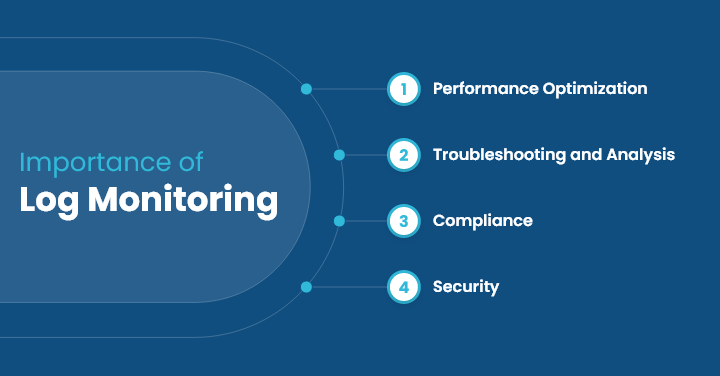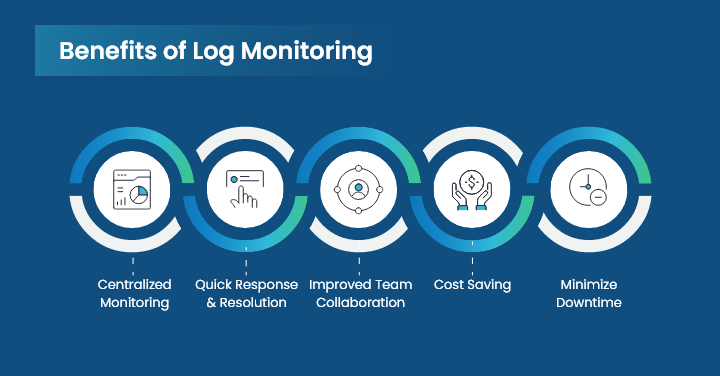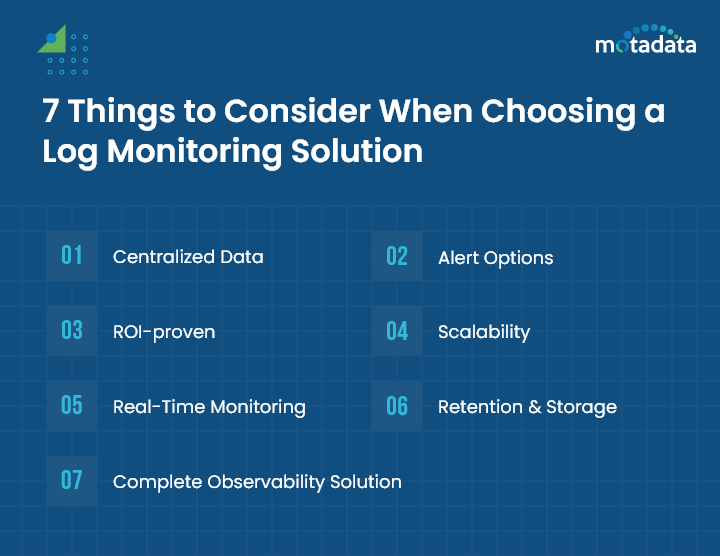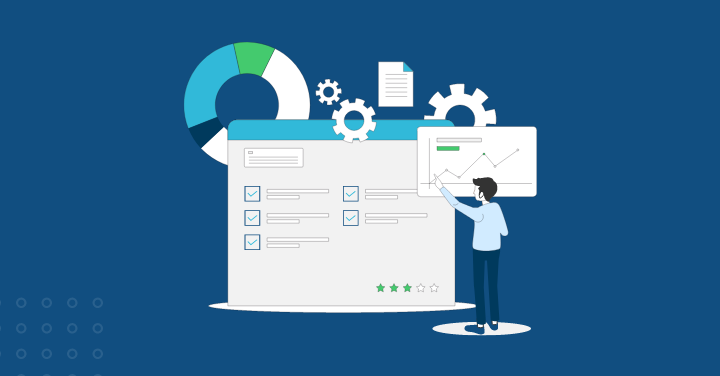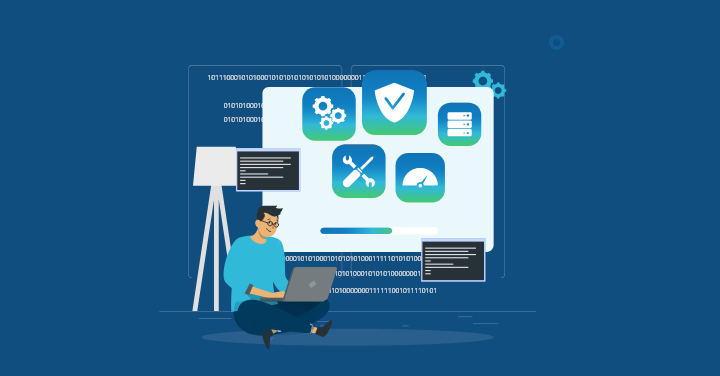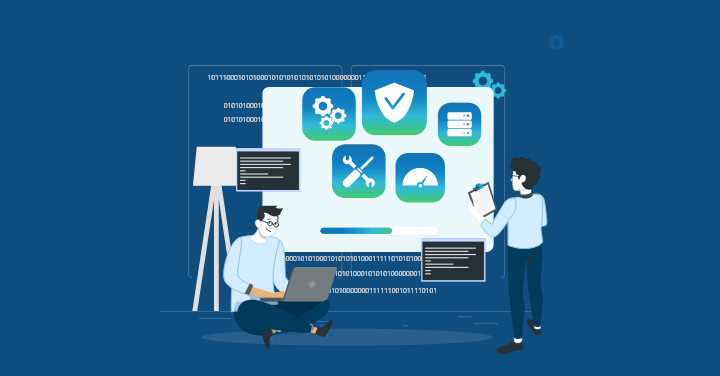Log monitoring has become crucial nowadays as more than 90% of organizations use cloud services, containers, and other technologies to stay ahead of their competitors.
This excessive adaption of the latest technologies and services is great for businesses but it also makes everything a bit more complex.
Consequently, the volume, velocity, and diversity of logs rise exponentially as a result of this complexity.
Hence, to exactly find out what is happening in complex environments, it is essential to maintain and monitor log files.
Log File Monitoring provides IT managers with quick visibility and real time insights into the operation of mission-critical applications and systems.
The log data analysis further helps identify duplicate entries and raises alerts on finding anything suspicious.
Let us learn more about log monitoring – its benefits, challenges, and best practices.
Further, we will highlight some of the main factors to keep in mind when selecting a log monitoring system.
What is Log Monitoring?
No matter how big or small your network is, log monitoring is an essential first step that helps organizations prevent, detect, and resolve problems on a network device.
The solution collects data from various sources including errors, performance metrics as well as system activities.
Businesses use these log files to run analysis and discover anomalies and performance issues.
Basically, with the help of this process, administrators and IT managers can better evaluate log data, quickly spot risks, and maintain the operations of the business.
Even DevOps teams can employ log monitoring solutions to ingest system, application, and service logs in order to identify problems at any point in the software delivery lifecycle (SDLC).
Importance of Log Monitoring
Many businesses in the market believe event log tracking won’t create much impact, especially if your business is running smoothly.
However, there are a few reasons why implementing log monitoring practices for your enterprise can benefit you in the long run.
1. Performance Optimization
It becomes easier for enterprises to identify bottlenecks with log records. Additionally, users can better manage their resources and improve application performance.
Log monitoring practice is great for issue resolution and delivering a better user experience.
2. Troubleshooting and Analysis
Enterprises can access insightful information from the collected log data as well as a quick update on the errors and performance in real-time.
Using these insights, the IT teams can perform quick root cause analysis, diagnose problems, get valuable context, and troubleshoot issues faster.
This may further lead to minimized downtime and better system stability.
3. Compliance
In compliance with several regulatory obligations and industry best practices, organizations are required to maintain comprehensive records and frequently evaluate them for compliance purposes.
It also aids in locating any suspicious activity or unlawful record alterations.
Log monitoring helps businesses identify and address data breaches so they can minimize risks to sensitive data as soon as possible.
4. Security
Even a single loophole in your system or human error can result in security risks.
But, if your enterprise performs log monitoring, chances are high that your team members can identify and address security issues before they create any major damage.
With real-time log monitoring and data analysis, you can safeguard your business from heavy losses.
However, security threats aren’t limited to external attacks—system file damage can also compromise performance and lead to unexpected failures if not addressed in time.
By using the best identity verification software, you can further reduce security vulnerabilities by validating user identities and preventing unauthorized access.
Additionally, the log monitoring system comes with a built-in alert feature that notifies as and when detects unauthorized access or suspicious activity.
Further, it enables you to run scans and analyze all the log files, enabling quick identification of weak points that might get attacked at an early stage.
To summarize, log monitoring is a critical tool that will help you secure your infrastructure.
Benefits of Log Monitoring
In cloud-native systems, log monitoring practice will help teams stay aware of the operations and situations.
There are numerous advantages to this approach, such as the following:
1. Centralized Monitoring
With the help of log monitoring tools, administrators can collect information from different sources such as network devices, operating systems, and cloud platforms in one place and later use it for analysis.
Using the data visualization and analytics features supported by the monitoring tool, businesses can further keep track of the overall issues and performance in real-time through business dashboards.
Another key feature, i.e., automation and artificial intelligence (AI) helps in evaluation of syslog files, telemetry, and timestamp data, resulting in quick troubleshooting.
2. Quick Response and Resolution to Incidents
With clear visibility into system logs businesses can faster identify, troubleshoot, and respond to incidents.
These insights further help find out the root cause of a problem and reduce the overall time taken to fix the issues.
In simple terms, it enables teams to respond to incidents more quickly and discover problems before they affect end users.
3. Improved Team Collaboration
Team members may collaborate and share insights from log data more easily when they use log monitoring solutions.
It further improves data analysis, sharing, and troubleshooting abilities.
The team as a whole benefit from increased visibility and comprehension of system events and performance due to this enhanced collaboration.
Additionally, dashboard visibility, email alerts, and notifications are provided by log monitoring technologies, which promote efficient teamwork and communication.
In simple terms, teams may collaborate more effectively, make wise decisions, and quickly address problems by utilizing the power of log monitoring.
4. Cost Saving
Efficient log monitoring maximizes system efficiency and lowers expenses related to performance problems.
You can save money by identifying areas for performance optimization and locating system bottlenecks with the help of log monitoring technologies.
It further allows early identification and resolution of system problems, reducing service interruptions and outages as well as associated expenses.
Further, optimizing log events using log monitoring software ensures effective resource utilization, which reduces high costs by providing useful indicators for capacity planning.
5. Minimize Downtime
The root cause of a problem can be found easily through log analysis, which speeds up the problem-solving process and reduces downtime.
Basically, these monitoring tools help find out the potential issues at a much initial stage and send alerts for quick fix, resulting in no to minimum downtime.
What are the Challenges of Log Monitoring?
No doubt there are several benefits to log monitoring but it also comes with various challenges, such as:
1. More Complexity
Many businesses use cloud services and the latest technologies to stay ahead of their competitors and deliver quality results.
Some even operate over data centers, cloud service providers, and remote locations as a result creating large volumes of data and storage more than before.
In such a case, managing and monitoring data of businesses with distributed infrastructure is highly complex and requires a unified approach to efficiently collect, organize, and examine logs.
2. Different Logging Formats
Imagine your business uses different systems and services, now maintaining logs for each system is quite challenging, especially when the volume of logs is increased exponentially.
Secondly, storing the collected data (both structured and unstructured) without a standard format is another challenge as it will take a lot of work and resources for observability experts to interpret the log.
Hence, to successfully monitor the logs, organizations must have a common format.
3. Older Data Silos
Instead of using a centralized system, many businesses still rely on the distributed ones.
Because of the volume generated, this technique not only has high expenses but also adds to the workload of operations and development teams, who may be more productive when data is centralized.
7 Things to Consider When Choosing a Log Monitoring Solution
There are several log monitoring solutions available in the market for companies who wants to boost their team productivity and efficiency.
But, to select the best one, you can consider Motadata for unified ITOps solutions, we have listed a few factors that one must consider:
1. Centralized Data
It is best to go in with a platform that provides centralized data as it will help collect, store, and analyze all log files from a single location.
Businesses with distributed infrastructure have large amounts of data from several sources that are of diverse types.
With a centralized view, things will be far simpler and effective for IT teams.
2. Alert Options
After log collection, the first and foremost step is to analyze all the files and identify error conditions.
With a custom alert feature, businesses will be able to get timely alerts on anomaly detection and respond to them faster.
To determine which log monitoring alerts require immediate attention and further investigation by IT operations teams, an efficient platform must filter and prioritize them.
You can even reduce end-user alert fatigue by integrating machine learning and AIOps into your monitoring.
3. ROI-proven
While selecting a tool shouldn’t be based solely on price, you should look for a platform that is affordable and has a positive return on investment.
Undertaking a cost analysis is a valuable step towards comprehending the pros and downsides of the log monitoring options you are evaluating.
4. Scalability
Another key factor to look for in log monitoring software is the ability to manage log data from multiple sources and perform real time monitoring.
Organizations can efficiently handle the growing amount of log data and guarantee the seamless operation of their applications and infrastructure by putting in place a scalable log monitoring solution.
5. Real-Time Monitoring
Enterprises can obtain insights into application performance, cloud logging, various systems, and regular operations by tracking logs in real-time.
With the help of this visibility, they can guarantee high availability and uptime by promptly recognizing and addressing service disruptions or performance bottlenecks.
Plus, proactive troubleshooting and root cause analysis are made possible by real-time log monitoring, enabling businesses to take care of possible problems before they become more serious.
6. Retention and Storage
In order to keep log data for compliance, troubleshooting, and analysis, your log management solution must provide high-capacity log storage.
Effective log file retention policies must be put in place in order to save expenses and satisfy data needs.
Make sure the log monitoring solutions also enable simple access to log data from different time periods, as well as convenient search and analysis capabilities.
7. Complete observability solution
Monitoring logs is merely one aspect of observability. Choose a platform that provides a full-suite observability solution to obtain the maximum value.
Log monitoring Best Practices
Here are a few best practices that should be taken into consideration to optimize the efficacy of log monitoring:
1. Understand Metrics
Log monitoring practice makes it easier for IT teams to identify and resolve issues before they become more serious.
It enables proactive monitoring of all threats, vulnerabilities, and security breaches and offers deep insights into the operations of applications that aid in improving user experience and system optimization.
Basically, businesses can increase their overall efficiency and make well-informed decisions by evaluating log data and understanding the different metrics like response time, error rate, and resource usage.
2. Centralized Log Management
Log data originates from a wide range of discrete sources, so at first, it needs to be collected in one place for examination and usage.
Cross-analysis and metrics are necessary for correlation in order to assess log data from all sources and determine the impact of an activity or event on different parts of the system.
This way, business-critical systems are not impacted when testing and debugging issues are carried out by IT personnel.
Moreover, it reduces the possibility of data loss in an autoscaled system and stops hackers from erasing log data.
3. Define Clear Objectives
Establishing clear goals for log monitoring is crucial to maximizing its advantages.
This entails knowing how important log monitoring is for spotting risks to the system and figuring out what precise objectives you want to use log monitoring for.
For instance, your goals can be to enhance system performance as a whole or quickly identify and address security issues.
Setting up a monitoring plan, reviewing procedures, and choosing the best log monitoring tools for your purposes are essential to achieving these goals.
Through the analysis of the data gathered via log monitoring, you may pinpoint areas in need of improvement and avert more problems.
4. Use Time Stamps Effectively
Log monitoring solutions can automate the extraction and analysis of time stamps, thereby streamlining the process and saving significant time and resources.
Further, you can increase the performance of your system and your log monitoring capabilities by making good use of time stamps.
5. Log Review for Compliance
Prioritize essential systems, security incidents, and compliance requirements as you create a regular schedule for reviewing and analyzing logs.
In order to comply with regulations and guarantee data protection, it is essential to routinely analyze logs for compliance.
It even helps identify and address system weaknesses before attackers misuse it.
Conclusion
For IT infrastructure to remain secure, stable, and functional, log monitoring is essential.
With the help of log monitoring systems, organizations can identify security risks faster, respond to incidents, and enhance performance by running proper log analytics.
Today, most businesses use advanced technologies to stay ahead of their competitors resulting in more accumulation of data sources.
Despite the difficulties involved in collecting, organizing, and interpreting massive amounts of log data, businesses can get over these barriers by using integrated, scalable, and adaptable log monitoring solutions.
Further, we have listed a few best practices, such as understanding metrics, centralized log management, and more that will help maximize the effectiveness of your log monitoring process and reduce downtime.
Also, we have penned down some of the key factors that one may consider while selecting the right log monitoring system.
To learn more about log monitoring solutions available in the market, you can explore tools like Motadata and others.
These solutions can help boost team productivity and efficiency in managing log data effectively.
FAQs
Log monitoring plays a vital role in cybersecurity by providing real-time insights into system activities. It helps detect and respond to security incidents, track unauthorized access, and identify patterns indicative of potential threats.
Log monitoring enables the detection of unusual or suspicious activities in log files, allowing security teams to identify potential security incidents promptly. It helps in preventing or minimizing the impact of security breaches.
Log monitoring helps organizations meet compliance standards by providing a detailed record of system activities. This information is often required for audits and regulatory reporting, ensuring that organizations adhere to industry-specific rules and regulations.
Log monitoring contributes to improved system performance by identifying and addressing issues that could lead to downtime or performance degradation. It allows organizations to proactively address potential bottlenecks and optimize system efficiency.



